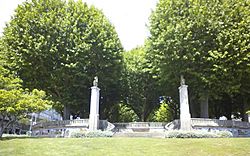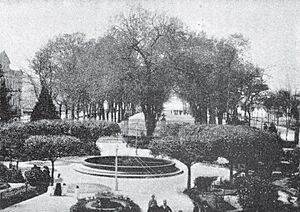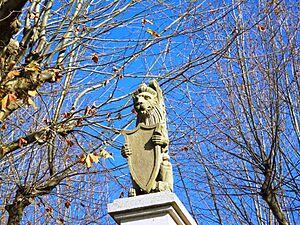Alameda de Pontevedra facts for kids
Quick facts for kids Alameda de Pontevedra |
|
|---|---|
 |
|
| Location | Pontevedra, Spain |
| Area | 0.021 km2 (5.18 acres) |
| Created | 1879 (present configuration) |
| Operated by | Municipality of Pontevedra |
| Status | Public park |
The Alameda de Pontevedra (officially called Alameda del arquitecto Sesmero) is a lovely public park in the city center of Pontevedra, Spain. People in Pontevedra often just call it la Alameda. It's the largest green area in the city center, right next to the Palm Trees Park. The Alameda is located west of the old town, close to the old fishing neighborhood of A Moureira.
Contents
History of the Alameda Park
The Alameda de Pontevedra got its current look in the late 1800s. This was part of a big plan to expand the city beyond its old city walls.
Before it became a park, this area had different names. It was known as the Field of Truth, where people who were found guilty were executed. It was also called the Field of Wheels, because ropes and fishing gear were made there. After the convent of St. Dominic was built nearby, it became known as the Field of St. Dominic.
In 1648, the Dominican monks turned their convent's garden into a walking area. Later, in 1846, a wall was built, the ground was made level, and trees and stone benches were added. By 1847, part of this field, which is now the Alameda, was fenced off with stone walls. The Alameda had five wide paths lined with trees and a spacious promenade. There were many oak and acacia trees. From here, people could enjoy a great view of the Pontevedra ria (a river estuary) and the sea. Wealthy residents of the city often walked here, especially on summer evenings, to enjoy the sea breeze.
The architect Alejandro Sesmero helped complete the park's design. He was part of the city's growth in the late 19th century. Sesmero presented his plan for the Alameda on April 29, 1879. In its early years, the Alameda had several parallel paths. These paths were used by different social groups. For example, the path closest to the current Gran Vía de Montero Ríos was for nannies and maids. The next path was for the middle class or artisans. The two paths near the current El Cafetín café were for the wealthy and noble families.
In 1886, Alejandro Sesmero was asked to design a bandstand for the park. This was part of the plan to improve the Alameda and Gran Vía area. In 1904, the bandstand was opened. It was used for concerts by musicians and artists. The bandstand has a stone base and a roof made of iron and glass. In 1907, it even got electric lights!
Later, in 1927, the city council asked architect Emilio Salado to make the western part of the Alameda even more beautiful. This area has amazing sea views. Salado designed a project influenced by Art Deco style. In 1928, a grand stone staircase was opened. It was decorated with two tall pillars, six meters high. These pillars had stone lions on top, holding the city's coat of arms. In the 1950s, these pillars were made much shorter. The stone lions were replaced with flower pots. But in 2010, the pillars and lions were put back to their original height and design.
The current El Cafetín café, on the north side of the Alameda, reminds people of an old café from the early 1900s. That old café was just a small kiosk selling drinks. In 1987, El Cafetín opened with its current look.
What You'll See at Alameda Park
The Alameda park has an oval shape. It stretches from near the Pontevedra City Hall in the Plaza de España towards San Roque. Rows of trees divide the park into several parallel walking paths. Together with the Gran Vía de Montero Ríos, the park covers an area of 21,000 square meters.
The western side of the Alameda has a viewpoint that ends with a stone staircase. This staircase is framed by two six-meter-tall columns. On top of these columns are two stone lions holding the city's coat of arms. The circular walls around this southern part have colorful tile mosaics. These were made by artist Carlos Sobrino. The bandstand is located on the Alameda side of the Gran Via de Montero Ríos.
Carlos Sobrino created twenty-three tile mosaics for the Alameda de Pontevedra. He painted different landscapes and scenes, both from the countryside and the city, in 1927. These tiles were made in Seville. They were fully restored in 2010 when the park was renovated.
The scenes on the tiles show traditional customs and buildings. You can see people in traditional clothes, the Hórreos (traditional granaries) of Combarro, the chapel of Nuestra Señora de la Lanzada, or the Plaza de la Leña in the old town, among others.
On its eastern side, the Alameda is bordered by the monument to the heroes of Puente Sampayo. This monument was designed by Julio González-Pola y García in 1911. It was built to celebrate 100 years since the Battle of Puente Sampayo against the French.
The Alameda still looks much like it did in the 19th century. It has dirt paths lined with five rows of trees, mostly poplars, black poplars, plane trees, lime-trees, Alders, Oaks, and two common hawthorn trees. You'll also find stone benches and the octagonal bandstand. The eastern entrance has a tall araucaria heterophylla tree, about 30 meters high, which is the largest tree in the park. The park is separated from the paved boulevard called Gran Vía de Montero Ríos by stone stairs.
Gallery
See also
 In Spanish: Alameda de Pontevedra para niños
In Spanish: Alameda de Pontevedra para niños
Related articles
- Plaza de España (Pontevedra)
- Gran Vía de Montero Ríos
- Palm Trees Park
- Island of Sculptures




















